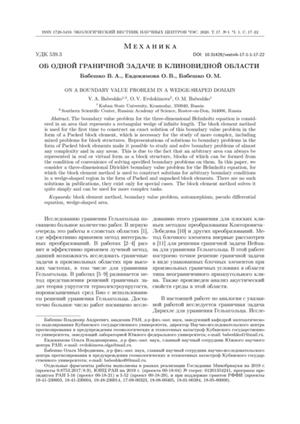Об одной граничной задаче в клиновидной области
УДК
539.3DOI:
https://doi.org/10.31429/vestnik-17-1-1-17-22Аннотация
Рассматривается граничная задача для трехмерного уравнения Гельмгольца в области, представляющей прямоугольный клин бесконечной протяженности. Методом блочного элемента строится в виде упакованного блочного элемента точное решение этой граничной задачи, необходимое для исследования более сложных, в том числе, смешанных задач для блочных структур.
Ключевые слова:
метод блочного элемента, граничная задача, автоморфизм, псевдодифференциальные уравнения, клинообразная областьИнформация о финансировании
Отдельные фрагменты работы выполнены в рамках реализации Госзадания Минобрнауки на 2019~г. (проекты 9.8753.2017/8.9), ЮНЦ РАН на 2019 г. (проекта 00-18-04) № госрег. 01201354241, программ президиума РАН I-16 (проект 00-18-21) и I-52 (проект 00-18-29), и при поддержке грантов РФФИ (проекты 19-41-230003, 19-41-230004, 19-48-230014, 17-08-00323, 18-08-00465, 18-01-00384, 18-05-80008).
Библиографические ссылки
- Бреховских Л.М. Волны в слоистых средах. М. Наука, 1973. 502 с. [Brekhovskikh L.M. Volny v sloistykh sredakh [Waves in layered media]. Nauka, Moscow, 1973. (In Russian)]
- Бабич В.М. О коротковолновой асимптотике функции Грина для уравнения Гельмгольца // Математический сборник. 1964. Т. 65. С. 577–630. [Babich V.M. O korotkovolnovoy asimptotike funktsii Grina dlya uravneniya Gel'mgol'tsa [On the short-wave asymptotics of the Green's function for the Helmholtz equation]. Matematicheskiy sbornik [Mathematical collection], 1964, vol. 65, pp. 577–630. (In Russian)]
- Бабич В.М., Булдырев В.С. Асимптотические методы в проблеме дифракции коротких волн. М.: Наука, 1972. 256 с. [Babich V.M., Buldyrev V.S. Asimptoticheskie metody v probleme difraktsii korotkikh voln [Asymptotic methods in the problem of short-wave diffraction]. Nauka, Moscow, 1972. (In Russian)]
- Cerveny v., Molotkov I.A., Psencik I. Rey Method in seismology. Praha, Univerzita Karlova, 1977. 216 p.
- Мухина И.В. Приближенное сведение к уравнениям Гельмгольца уравнений теории упругости и электродинамики для неоднородных сред // ПММ. 1972. Т. 36. P. 667–671. [Mukhina I.V. Priblizhennoe svedenie k uravneniyam Gel'mgol'tsa uravneniy teorii uprugosti i elektrodinamiki dlya neodnorodnykh sred [Approximate reduction to the Helmholtz equations of the equations of elasticity theory and electrodynamics for inhomogeneous media]. Prikladnaya matematika i mekhanika [Applied Mathematics and Mechanics], 1972, vol. 36, pp. 667–671. (In Russian)]
- Молотков Л.А. Исследование распространения волн в пористых и трещиноватых средах на основе эффективных моделей Био и слоистых сред. Санкт-Петербург. Наука, 2001. 348 с. [Molotkov L.A. Issledovanie rasprostraneniya voln v poristykh i treshchinovatykh sredakh na osnove effektivnykh modeley Bio i sloistykh sred [Study of wave propagation in porous and fractured media based on effective Bio and layered media models]. Nauka, Saint petersburg, 2001. (In Russian)]
- Новацкий В. Теория упругости. М.: Мир, 1975. 872 с. [Novatskiy V. Teoriya uprugosti [Elasticity theory]. Mir, Moscow, 1975. (In Russian)]
- Новацкий В. Динамические задачи термоупругости М.: Мир, 1970, 256 с. [Novatskiy V. Dinamicheskie zadachi termouprugosti [Dynamic problems of thermoelasticity]. Mir, Moscow, 1970. (In Russian)]
- Новацкий В. Электромагнитные эффекты в твердых телах. М.: Мир, 1986. 160 с. [Novatskiy V. Elektromagnitnye effekty v tverdykh telakh [Electromagnetic effects in solids]. Mir, Moscow, 1986. (In Russian)]
- Беркович В.Н. К теории смешанных задач динамики клиновидных композитов // ДАН. 1990. Т. 314. № 1. С. 172–175. [Berkovich V.N. K teorii smeshannykh zadach dinamiki klinovidnykh kompozitov [On the theory of mixed problems of the dynamics of wedge-shaped composites]. Doklady Akademii nauk [Reports of the Academy of Sciences], 1990, vol. 314, no. 1, pp. 172–175. (In Russian)]
- Бабешко В.А., Евдокимова О.В., Бабешко О.М. К проблеме акустических и гидродинамических свойств среды, занимающей область трехмерного прямоугольного клина // Прикладная механика и техническая физика. 2019. Т. 60. № 6. С. 90–96. DOI: 10.15372/PMTF20190610 [Babeshko V.A., Evdokimova O.V., Babeshko O.M. K probleme akusticheskikh i gidrodinamicheskikh svoystv sredy, zanimayushchey oblast' trekhmernogo pryamougol'nogo klina [On the problem of acoustic and hydrodynamic properties of a medium occupying the region of a three-dimensional rectangular wedge]. Prikladnaya mekhanika i tekhnicheskaya fizika [Applied Mechanics and Technical Physics], 2019, vol. 60, no. 6, pp. 90–96. DOI: 10.15372/PMTF20190610 (In Russian)]
- Бабешко В.А., Евдокимова О.В., Бабешко О.М., Рядчиков И.В. Метод проектирования неоднородных материалов и блочных конструкций // ДАН. 2018. Т. 482. № 4. С. 398–402. DOI: 10.1134/S1028335818100014 [Babeshko V.A., Evdokimova O.V., Babeshko O.M., Ryadchikov I.V. Metod proektirovaniya neodnorodnykh materialov i blochnykh konstruktsiy [The method of designing heterogeneous materials and block structures]. Doklady Akademii nauk [Reports of the Academy of Sciences], 2018, vol. 482, no. 4, pp. 398–402. DOI: 10.1134/S1028335818100014 (In Russian)]
- Бабешко В.А., Бабешко О.М., Евдокимова О.В. О проблеме блочных структур академика М.,А. Садовского // ДАН. 2009. Т. 427. № 4. С. 480–485. [Babeshko V.A., Babeshko O.M., Evdokimova O.V. O probleme blochnykh struktur akademika M.A. Sadovskogo [On the problem of block structures of academician M.A. Sadovsky]. Doklady Akademii nauk [Reports of the Academy of Sciences], 2009, vol. 427, no. 4, pp. 480–485. (In Russian)]
- Бабешко В.А., Евдокимова О.В., Бабешко О.М. О стадиях преобразования блочных элементов // ДАН. 2016. Т. 468. № 2. С. 154–158. [Babeshko V.A., Evdokimova O.V., Babeshko O.M. O stadiyakh preobrazovaniya blochnykh elementov [About the stages of transforming block elements]. Doklady Akademii nauk [Reports of the Academy of Sciences], 2016, vol. 468, no. 2, pp. 154–158. (In Russian)]
- Федорюк М.В. Метод перевала. М.: Наука, 1977. 368 с. [Fedoryuk M.V. Metod perevala [Pass Method]. Nauka, Moscow, 1977. (In Russian)]
Скачивания

Загрузки
Даты
Поступила в редакцию
Принята к публикации
Публикация
Как цитировать
Лицензия
Copyright (c) 2020 Бабешко В.А., Евдокимова О.В., Бабешко О.М.

Это произведение доступно по лицензии Creative Commons «Attribution» («Атрибуция») 4.0 Всемирная.


